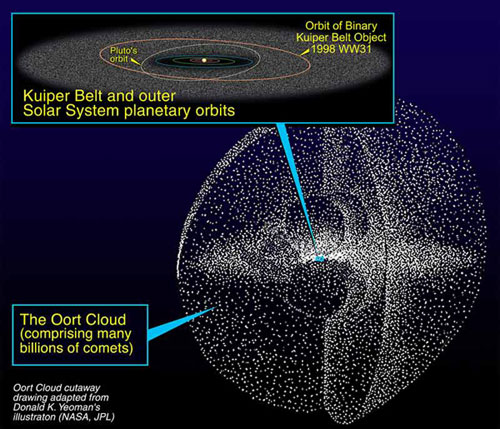The Oort Cloud: Faith Without Evidence
Atheists and evolutionists mock biblical creationists for believing in the observed work of the Creator, but have their own blind faith and "miracles". One example is their fact-free presuppositional assertions that neutron stars make gold in space. Another example of faith in their own schemes is discussed below.
A serious problem for long-age cosmic evolution is the existence of comets. Those nuclei of those bad boys are small by astronomical standards (but you would not want one in your driveway), and are seen when they get close enough to the sun. Then, some of the surface burns off and we see the glow and long gaseous tail. They go orbiting again, and more of the nucleus burns off on the next pass. Repeat and fade until nothing is left, or it crashes into a planet or something. Using the dating methods and assumptions of secular scientists, comets should not exist because they would have been entirely used up millions of Darwin years ago.
This is where the scientific principle of Making Things Up™ comes into play. In 1932, Ernst Öpik said, "Hey, I got this!" and proposed a rescuing device, which Jan Oort agreed with in 1950. The excuse usually bears the name of the latter: the Oort cloud. Way, way out yonder, beyond Neptune's orbit and the Kuiper belt, a fantastical cloud of clutter repopulates the comets. Story goes, this happens when something kicks around some of the contents and they go into their odd orbits. Voila, comets still exist! This cloud is alleged to be a huge bubble-like thing with two chambers.
The Oort cloud is convenient, and invoked when comets are discovered, which smacks of confirmation bias. Interestingly, even the heavily-biased Wikipedia admits that the Oort cloud is theoretical. Take a look-see at this short children's indoctrination piece from NASA, and
note how many "facts" are asserted, even though they have no
verifiable scientific evidence:
Remember, kids, having faith in something even though you know it isn't true (to repurpose a quote from Samuel Clemens) is science. Secularists resort to some desperate measures to deny recent creation, and indeed, the Creator himself. Dreaming up things such as the Oort cloud, dark matter, space aliens, the Big Bang, or the giant ice wall surrounding the flat earth can seem plausible. However, scientists supposedly rely on empirical data. Guess that's changed. Interesting that they believe in fictions that they willingly fabricated, but deny the evidence for and testimony of God.
A serious problem for long-age cosmic evolution is the existence of comets. Those nuclei of those bad boys are small by astronomical standards (but you would not want one in your driveway), and are seen when they get close enough to the sun. Then, some of the surface burns off and we see the glow and long gaseous tail. They go orbiting again, and more of the nucleus burns off on the next pass. Repeat and fade until nothing is left, or it crashes into a planet or something. Using the dating methods and assumptions of secular scientists, comets should not exist because they would have been entirely used up millions of Darwin years ago.
This is where the scientific principle of Making Things Up™ comes into play. In 1932, Ernst Öpik said, "Hey, I got this!" and proposed a rescuing device, which Jan Oort agreed with in 1950. The excuse usually bears the name of the latter: the Oort cloud. Way, way out yonder, beyond Neptune's orbit and the Kuiper belt, a fantastical cloud of clutter repopulates the comets. Story goes, this happens when something kicks around some of the contents and they go into their odd orbits. Voila, comets still exist! This cloud is alleged to be a huge bubble-like thing with two chambers.
 |
| NASA / JPL, based on illustration by Donald K. Yeoman (Usage does not imply endorsement of site contents) |
Remember, kids, having faith in something even though you know it isn't true (to repurpose a quote from Samuel Clemens) is science. Secularists resort to some desperate measures to deny recent creation, and indeed, the Creator himself. Dreaming up things such as the Oort cloud, dark matter, space aliens, the Big Bang, or the giant ice wall surrounding the flat earth can seem plausible. However, scientists supposedly rely on empirical data. Guess that's changed. Interesting that they believe in fictions that they willingly fabricated, but deny the evidence for and testimony of God.
When I was growing up, the definition of science was simple: “the study of the natural world using the five senses.” This definition placed some limits upon science. For instance, science was restricted to the study of the natural world, so anything supernatural was out of bounds to science. Supernatural things include miracles, angels, souls, and God. Even if something is part of the natural world, it wasn’t considered scientific unless we could detect it with our five senses.To read the rest or download the MP3 version, click on "Oort Cloud—No Evidence Required". Also, for more about comets and recent discoveries, click on "Comets - Their Silent Testimony".
Over the years, however, many scientists found this definition too confining. So they gradually redefined science as “the search for natural explanations.” This newfangled view of “science” studies things we can’t even detect. The Oort cloud is a good example. It was included among the “11 Scientific Wonders We Know Exist—but We’ve Never Seen” featured in a cover article in New Scientist last year [March 2016].